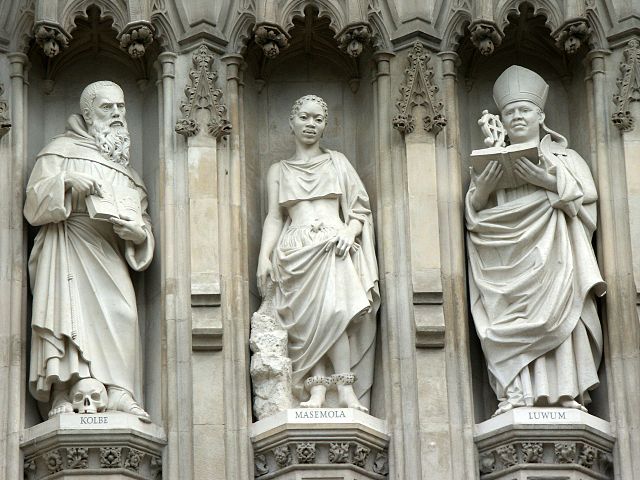
Westminster Abbey sculptures honor 20th-century martyrs Maximilian Kolbe (left), Mache Masemola, and Janani Luwum. |
By John Martin
Nearly 40 years after the martyrdom of Archbishop Janani Luwum, the Church of Uganda has announced it wants to turn the building where he died into a place of pilgrimage. The Archbishop was murdered by the dictator Idi Amin on Feb. 16, 1977, after being detained at the Nakasero State Research Bureau, widely known as Amin’s slaughterhouse.
In 2015, Uganda’s President Yoweri Museveni declared Feb. 16 a national holiday known as St. Janani Luwum Day. The late archbishop was a leading critic of the Amin regime’s excesses. Amin displaced President Milton Obote in a coup in 1971. In 1977 he delivered a note protesting against arbitrary killings and unexplained disappearances. Shortly afterward he and other church leaders were arrested on charges of treason.
Luwum and others were paraded at a rally organized by Amin in the capital city of Kampala. He was accused of being an agent of Obote and supporting an attempted coup. The next day Radio Uganda announced that he and two detained cabinet ministers, Wilson Oryema and Charles Oboth Ofumbi, were killed in a car collision.
The regime said the men had tried to overpower the driver. When the Archbishop’s body was released to relatives, however, it was riddled with bullets. He had been shot through the mouth and three bullets penetrated his chest.
Janani Luwum was survived by his widow, Mary, and nine children. He was buried in his home village, Mucwini, in the Kitgum area of northern Uganda.
The Provincial Assembly of the Church of Uganda has formally asked the government to designate the State Research Bureau headquarters as a religious tourism and pilgrimage site.
The church has asked the same for the village of Mucwini. The Diocese of Kitgum, which owns the site, plans to use it for a university, a hospital, a martyrs’ village, a TV station, and a museum.
The Royal Clarence Is Lost
A disastrous fire which at one stage threatened Exeter’s Norman cathedral has left England’s oldest hotel a heap of rubble. Only part of its façade remains standing.
The Royal Clarence Hotel, situated on the cathedral green in Exeter’s city center, was lost Nov. 4 when a blaze spread from an adjacent building. The Rt. Rev. Robert Atwell, Bishop of Exeter, praised the fire service Nov. 6 for working so diligently to protect other buildings on the cathedral green.
Atwell said he hoped the frontage would be rebuilt. “All the historic stuff inside has gone, you can’t replace it, but at least I hope and pray that they rebuild the frontage as it was, because it deserves to be there, because that’s what will preserve at least the veneer of the architectural continuity,” he said.
Among the losses were human bones dating back to the Norman Conquest, sealed inside a glass case, which were a popular tourist attraction.
The Blight of Wasted Food
The Archbishop of Canterbury has thrown his weight behind a campaign to tackle the problem of food waste. Hunger, he said, is “a shocking blight on society.”
He joined Sadiq Khan, mayor of London, and opposition leader Jeremy Corbyn in delivering food to charity groups as part of a campaign by the London Evening Standard.
Hunger is a growing issue in the United Kingdom, and many churches are engaged in running food banks. In London an estimated 400,000 people struggle to feed themselves. Food waste is a growing problem as well. Food stores are obliged the throw out perfectly edible food because it has passed its sell-by date.
Welby said the reasons for food waste are complex but that “more needs to be done to highlight this issue.” The Sainsbury’s supermarket chain has led the way in teaching customers about the extent of food waste and what can be done to counter it.









